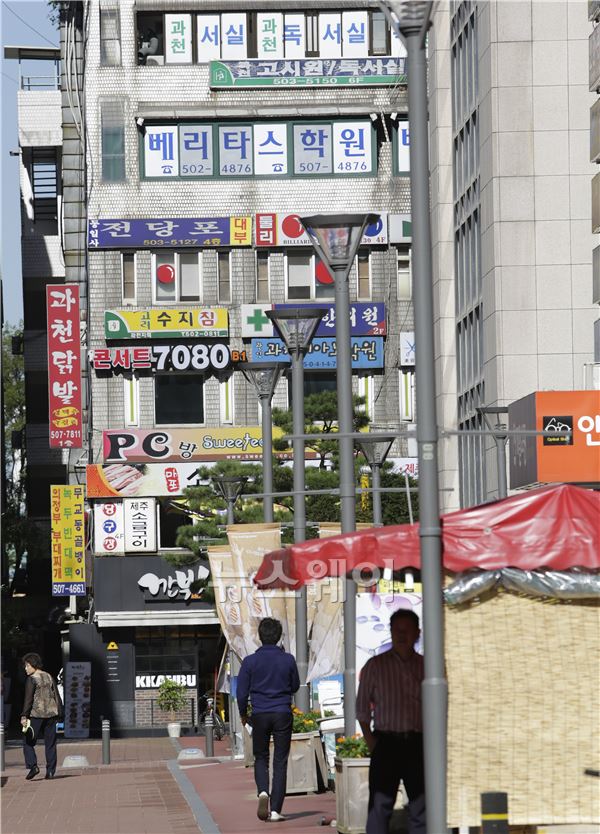Return on loan interest rate must be higher than 2%
Sales price adequacy and location ‘checkpoints’ | | Miljiljip Station, a neighborhood shopping district near the Gwacheon Government Complex in Jungang-dong, Gwacheon-si, Gyeonggi-do. Photo = Newsway DB | |
|
Middle-aged people, especially retired baby boomers, are showing keen interest in preparing for retirement. Taking advantage of this atmosphere, investment in neighborhood shopping malls, which can generate a certain amount of rental income with small investment funds, has become popular recently.
We analyzed smart investment strategies for retirement through Remax Korea, the domestic branch of RE/MAX, the world's largest single-brand real estate franchise.
Neighborhood shopping malls usually refer to buildings containing businesses such as pharmacies and academies in residential areas, subway areas, or commercial areas within residential districts. Most of them are 4 to 5 floors in size, and they mainly refer to commercial buildings installed in one building with an area of less than 1,000 m2 (approximately 302 pyeong).
Most of them are located near large-scale residential areas, so the economic ups and downs are relatively less than other products, so the vacancy rate is low.
Therefore, it is a good idea to start looking around your residence and find out for yourself. A good way is to research and select an area where you can quickly learn about changes in the commercial area and are easy to manage.
In addition, you can avoid disappointment by using the mortgage loan interest rate as a standard for investment return when deciding whether to invest.
For example, when investing in a neighborhood shopping mall worth 200 million won, if the deposit is 30 million won, the net investment amount is 'commercial price 200 million won - deposit 30 million won = 170 million won.' If you divide 17 million won, which is 10% of this 170 million won, by 12 months, it becomes approximately 1.4 million won per month.
At least this 1.4 million won must be received every month to be considered a worthwhile investment. The reason why 10% per year is used as the rate of return is because the commercial mortgage loan interest rate is in the range of 6 to 7% per year. The rate of return must be at least 3% higher than this to prepare for taxes or unexpected vacancies.
Rent varies depending on location conditions and population. Therefore, it is necessary to pay attention to apartment complex areas, main streets, and subway areas.
Among these, it is advantageous to be located in a central or representative commercial area within the region. Conversely, even in the same commercial area, it is best to avoid alley shopping malls where pedestrian traffic is interrupted.
Areas with a high supply of commercial properties due to a high ratio of commercial land should also be cautious, and if it is a commercial complex within a complex, the size of the complex behind it must be at least 500 households or more to maintain a stable commercial district.
Among neighborhood shopping malls in such locations, the first-floor shopping malls that are easily visible and easy for consumers to enter have the best marketability. It is easy to think that even if the floor is high, you just need to get an immediate rate of return, but you should keep in mind that it may not be easy to find a tenant.
Another way to verify a commercial area is to look at nearby stores. Usually, there are financial districts, academy districts, hospitals, etc. on the main streets, and mid- to low-priced restaurants, entertainment districts, and clothing stores are located on the side streets.
There is a lot of interest in neighborhood shopping malls in residential areas due to the expectation that the sale price will be higher than the sale price, thereby maximizing returns, but there are also caveats.
If a large discount store or department store opens nearby, the commercial district may not meet expectations, and it is necessary to consider how long it takes to form a commercial district and whether the return on sales price is appropriate.
Jang Jin-taek, director of Remax Korea, advised, “You must carefully look at the interim payment schedule, overdue interest rate, expected store opening date, confirmed profit, etc., so that you have a way to receive compensation or appeal when things go wrong.”
 Kim Ji-seong | kjs@newsway.co.kr Kim Ji-seong | kjs@newsway.co.kr
Original link: http://news.newsway.co.kr/view.php?tp=1&ud=2014021306323040652&md=20140224073000_AO
|